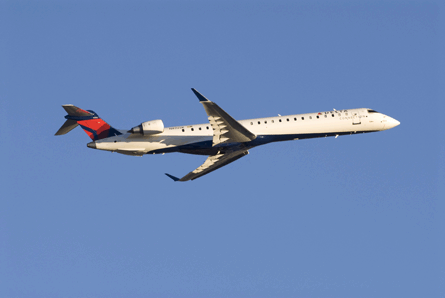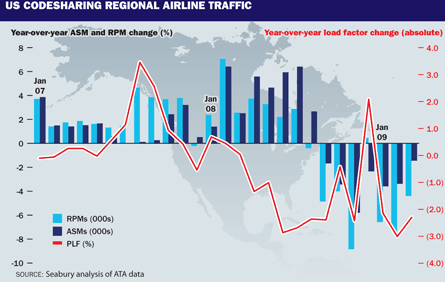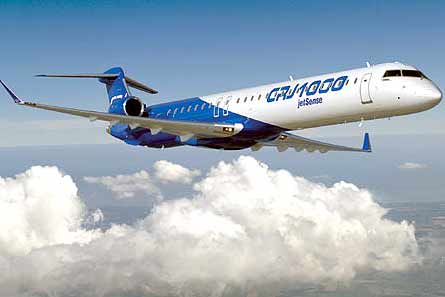Ask a US regional carrier to describe its operating experience over the past year and "rollercoaster ride" may be among the metaphors employed. Small regional jets, which have long served as the backbone of the US hub-and-spoke system, became untenable to operate in a cost-efficient manner when fuel prices spiked in 2008. Even though fuel has moderated, regional carriers - like their US major partners - now face dramatic reductions in yield as business travel has fallen off the map.
"I want to underscore how susceptible this business is. Load factors for US codesharing regionals fell 11 months out of 12 year-over-year until March 2009," says Seabury Group senior vice-president Doug Abbey.
 |
|---|
© Josh Akbar |
While several US regionals are somewhat insulated to market volatility by capacity purchase agreements that provide reimbursement for pass-through costs such as fuel, these arrangements are falling out of favour. Major carriers are no longer content to see their feeders enjoy dramatically higher profit margins than their own.
At the same time, the regional landscape has become quite fluid. Abbey points out, for example, that the Baltimore-Boston market, originally primarily served by mainline aircraft, transitioned to primarily regional jets post-9/11 and has now reverted to mainline jet flying (see Boston-Baltimore chart).
Consequently, as regional carriers prepare to descend on the Regional Airline Association's (RAA) annual conference and exhibition on 18-21 May in Salt Lake City, Utah, they are finding it difficult to predict what the future may hold.
Unwilling to rest on their laurels and simply wait for the economic crisis to ease, some regionals are taking cost-reduction steps now so that they can present a good case to mainline operators when capacity purchase and other feeder agreements come to their natural end. Others are forging ahead with new business strategies that involve assuming more risk and reducing reliance on US majors.
AVOIDING PANIC
St George, Utah-headquartered SkyWest refuses to be panic stricken by current economic challenges. The carrier, which provides regional lift to Delta Air Lines and United Airlines with a large fleet of Bombardier CRJ200s, CRJ700s, CRJ900s and Embraer EMB-120 Brasilias, is focused on having a higher quality operation than anybody else. It is doing "everything we can" to be cost efficient, such as creating fuel conservation programmes to help major partners, and taking good care of employees and investors, says chairman and chief executive Jerry Atkin.
"Our people work hard, and we partner now so that when it's time for contract renewal, we'll be in a good position in terms of quality and cost efficiency to expand our operation in the longer term."
 |
|---|
This year the company will take delivery of 18 new CRJ700s that are generally intended to replace the Brasilias under United. Delta Connection carrier Atlantic Southeast Airlines, a SkyWest subsidiary, is also bringing in 10 new CRJ900s.
"Those are two fairly significant opportunities that are going on in fairly challenging times. We also got nine airplanes back out of Midwest [Airlines] and we've placed all nine of them - seven with United and two we leased to Belarus," says Atkin, noting that all capacity at SkyWest has been spoken for.
"That is not easy to do in today's environment. We're lucky to find opportunities and have people talk to us."
While there are "little opportunities in today's challenging times", more significant openings could arise in the near future. Some major airline pilot contracts will become amendable in 2011 and 2012. Then, pilots will have to consider whether to further relax scope clauses that have dictated that three-quarters of the US regional fleet remains at 50 seats.
"How long the current flying will remain constrained by scope, I don't know. I think airlines will be aiming for 90 seats, maybe as much as 100 [when negotiating with pilots]. But there is a lot of carriers that don't have anything or have extremely limiting scope in the 70-seat category," says Atkin.
At the same time, he says, technology is "continuing to improve and airplanes that are in the planning stages are being offered that have improved reduced fuel burns and reduced maintenance costs. And so the cost of the 70- to 100-seat airplanes are going to go down because of the new technology being offered."
Bombardier - which plans to bring the new 100-seat CRJ1000 to market in early 2010 - is optimistic that upgauging will take place at North American regional operators.
 |
|---|
© Bombardier |
"In our 2008-27 forecast we note the removal of older mainline fleet types will create demand for new, small, single-aisle aircraft and large regional aircraft alike. With fuel prices as the key driver, network optimisation and the implementation of highly fuel-efficient aircraft will be the focus of the mainline operators," says the manufacturer.
In November, Embraer released a 20-year market forecast predicting a 10% drop in demand for regional jets, which included a 60% decline for the 30- to 60-seat market sector.
It also lowered its outlook for higher-capacity types, dropping the 61- to 90-seat forecast by 6% to 2,450 jets, and the 91- to 120-seat segment by 3% to 3,650.
But the Brazilian airframer says these two capacity brackets should "continue to help" carriers to match capacity to demand by "right-sizing" routes operated by narrowbody types with low load factors.
ASSUMING THE BURDEN
In line with up-gauging, however, regional carriers may need to take greater responsibility for variable costs. "I think it is incumbent upon regional partners to take more risk," says Seabury's Abbey.
SkyWest has already taken tentative steps in this regard, forging pro-rata agreements whereby it carries Delta and United's codes on service to certain small markets in Wyoming and Oregon, but assumes responsibility for the pricing and for fuel.
While the new services are not subsidised through the government's essential air service (EAS) programme, SkyWest has "entered into a partnership with the communities and I think there is probably more of that as well", says Atkin.
 |
|---|
SkyWest serves only two government-subsidised markets with 30-seat Brasilias, the smallest aircraft type in its fleet. "A lot of the EAS markets struggle supporting a 19-seat airplane. The number of EAS markets that fit the aircraft size we operate is fairly limited," says the SkyWest chief executive.
Indeed, a growing number of small communities are coming to grips with the fact that they cannot support 50-seat, 30-seat or even 19-seat service. But a nine-seat service, like the one flown by Cape Air, is gaining in popularity.
Based in Hyannis, Massachusetts, Cape Air operates in New England, New York, the Caribbean, Florida, the Mid-Atlantic and Micronesia with a fleet of 56 nine-seat Cessna 402s and two 46-seat ATR 42s.
"In a lot of the cases with the cities we're serving, we are not offering fewer seats. We're replacing less-frequency/high-gauge service with high-frequency/low-gauge service," says founder and chief executive Dan Wolf.
The carrier, a codeshare partner with Continental Airlines in the Caribbean and with JetBlue Airways in New England, recently launched EAS-supported services linking Baltimore with Hagerstown, Maryland and Lancaster, Pennsylvania.
"Lancaster and Hagerstown are perfect. The two cities meet Cape Air's minimal scaling of three aircraft using one spare as back-up," says Wolf.
He says the carrier is looking again at introducing service in the Midwest, after an attempt in Indianapolis failed. "If you draw a line from Chicago to New Orleans and look at 250 miles [400km] on either side of that line, there are some communities that would benefit from Cape Air service."
So sure is Cape Air in its strategy that it is in talks with airframers over its options for eventually replacing its Cessna 402s.
MULTI-ENGINE PARADIGM
"We're having conversations with various manufacturers that would be able to work with us. But we believe in a multi-engine paradigm. Our request is a multi-engined, nine-passenger aircraft with acquisition costs and operating costs around where the Cessna 402 is," says Wolf.
The RAA, meanwhile, is expressing cautious optimism that EAS will be strengthened under President Barack Obama's administration, providing regionals with further growth opportunities in a downmarket. "Already, the current administration is better than the prior administration," says RAA president Roger Cohen.
The new administration's proposed budget would increase funding for EAS by $55 million. However, FAA reauthorisation legislation in the House of Representatives would provide for $200 million in funding while modifying the EAS subsidy formula to reflect the cost of fuel retroactively.
CHARTING NEW TERRITORY
Another carrier taking an alternative approach to classic regional feed is ExpressJet, which is in the midst of building its charter business.
ExpressJet retained about 30 aircraft for charter and corporate flying in 2008 after dissolving its branded flying and returning 39 Embraer ERJ-145s to Continental as part of a new air services agreement the two companies reached in July 2008.
During a recent earnings call, ExpressJet chief executive Jim Ream admitted to a mixed outlook for the company's charter operation, but said he was happy with the first quarter as the performance of that business mirrored the fourth quarter's strong results.
Seabury's Abbey points out that since corporate jets "have a bit of a bad reputation", regional jet charters "may be more palatable" from a public relations standpoint.
Source: Flight International























